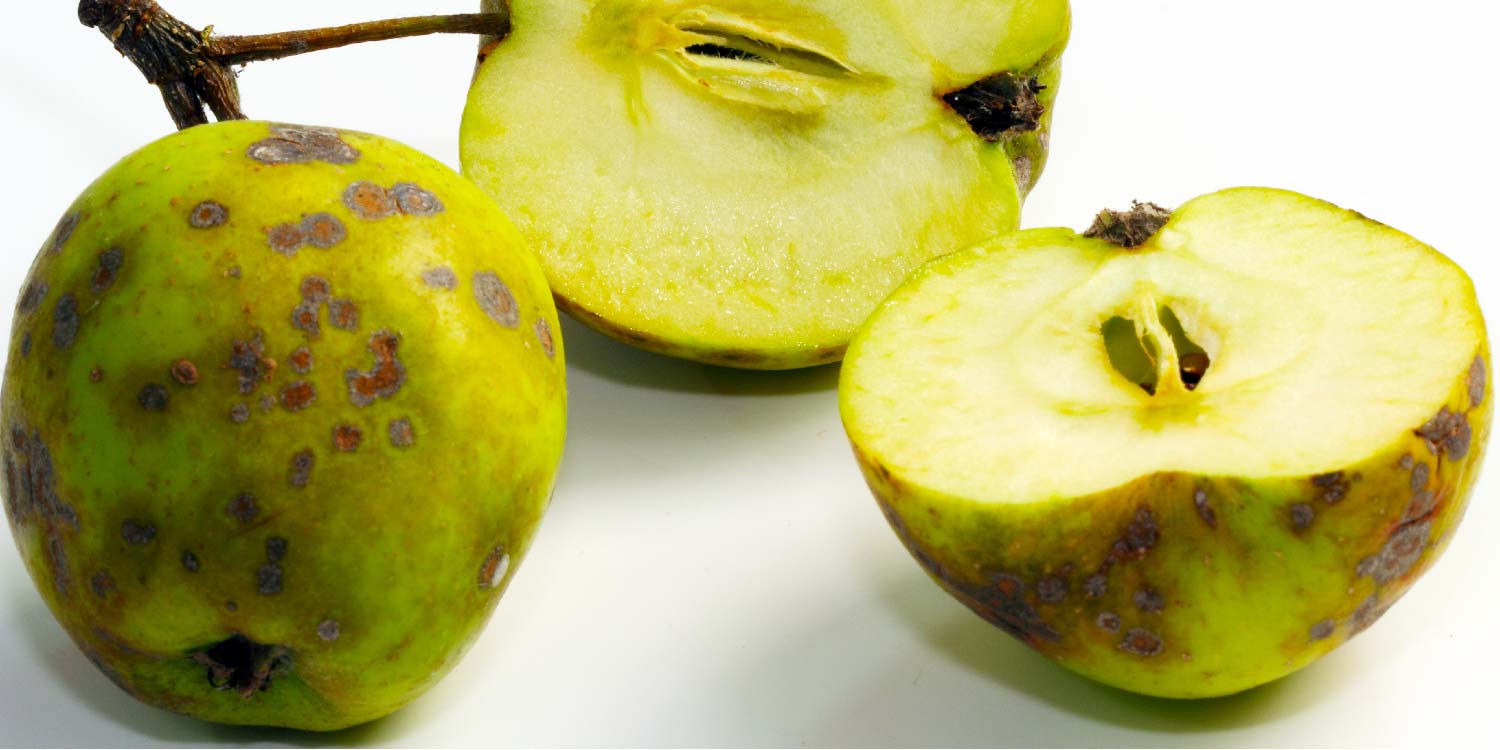The apple scab is a troublesome fungal disease for apple growers which is caused by the ascomycete fungus Venturia inaequalis that infects both leaves and fruits.
The disease manifests as dull black or grey-brown lesions on the surface of tree leaves, buds or fruits and lesions may also appear less frequently on the woody tissues of the tree. Fruits and the undersides of leaves are especially susceptible.
Although the disease rarely kills its host, it can significantly reduce fruit yields and fruit quality.
Scabby fruits are unfit for eating and less marketable due to the presence of the black fungal lesions.
DISEASE CYCLE
Apple scab survives primarily on infected leaves that have fallen to the ground and in the soil. In spring, spores are ejected from last season’s fallen leaves and create new infections on the young leaves and tiny fruitlets. Leaf spots quickly mature and produce new fungal spores which spread to other leaves to create new infections throughout the growing season.
Fungal spores are spread from primary lesions by splashing rain drops and wind to flowers, leaves or fruits, and initiate further infections when the combination of temperature and leaf wetness enables them to germinate and become established. These are called secondary infections, and generally occur within a tree or between adjacent trees rather than at a long distance.
The secondary cycle can be repeated many times during the growing season, and with frequent rainfall, the control of apple scab can be extremely difficult, particularly if the disease becomes established from primary infections.
During damp or rainy periods, newly opening apple leaves are extremely susceptible to infection. The longer the leaves remain wet, the more severe the infection will be.
Disease development and spread is favored by wet, cool weather.
SYMPTOMS
Disease symptoms usually start on the undersides of leaves and symptoms on fruits are similar to those found on leaves.
Initially, small, irregular spots/lesions that are light brown to olive green in color form. As infection continues, these lesions become more circular and velvety olive green in color and eventually turn dark brown to black.
Infected tissue thickens, causing the upper surface to bulge upwards and the lower surface to depress.
Lesions on older leaves are typically raised, dark green to gray brown with distinct margins, and cause cupping on the underside of the leaf. Leaves that are heavily infected with scab become curled/twisted, shriveled and puckered and fall from the tree prematurely.
If the leaf petioles become infected, the leaves drop early, while if the pedicels become infected, the fruits may drop early.
Scab infections on young fruits start out as olive green to brown spots. As the lesions enlarge, they harden and eventually become black, corky, inedible areas on the fruit.
Severely infected fruits may be deformed and often crack open.
Infections occur during moist conditions (rain, dew or constant irrigation) and temperature affects the severity of infections.
MANAGEMENT
Chemical method
A fungicide spray schedule should be followed on more susceptible host varieties, if complete disease control is the goal.
Thorough and uniform covering of all leaves and developing fruits is required for an effective control. A commercial spreader-sticker, INTEGRA, ensures thorough coverage of the foliage with the fungicide.
The following fungicides are fit for use against apple scab.
- TRINITY GOLD 452WP 50g/20l
- COLONIZER 440WP 50g/20l
- ABSOLUTE 375SC 10ml/20l
- GREENCOP 500WP 50g/20l
- CHANCETYL ELITE 800WDG 50g/20l
- EXEMPO CURVE 250SC 15ml/20l
- GEARLOCK TURBO 250WP 25g/20l
Non-chemical methods
- Follow good sanitation practices.
- Remove and destroy infected leaves, flowers, and fruit as soon as possible.
- Grow resistant varieties whenever possible.
- Rake under trees and destroy infected leaves to reduce the number of fungal spores available to start the disease cycle over again.
- Water in the evening or early morning hours (avoid overhead irrigation) to give the leaves time to dry out before infection can occur.
- Practise rotations with non-host plants
Tips!
- A fungicide resistance management strategy should be followed because the fungus can rapidly develop resistance to fungicides.
- A proper nutrition is key to an improved crop immunity.
- Repeat sprays should be done for effective control.
- Timely management of the disease is very important.






